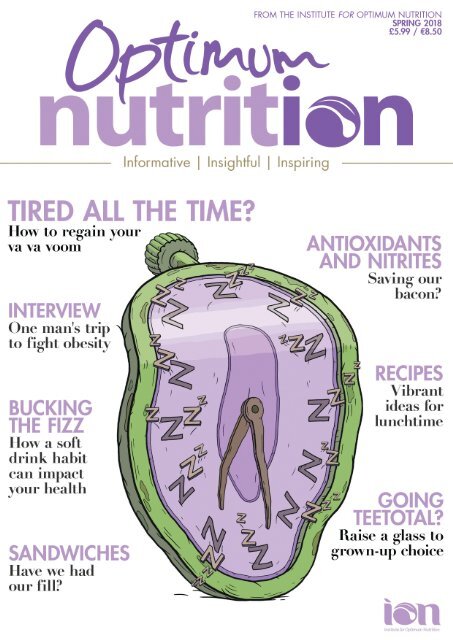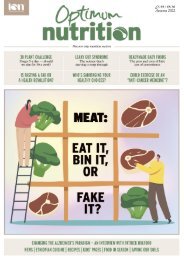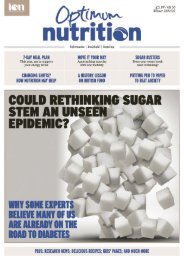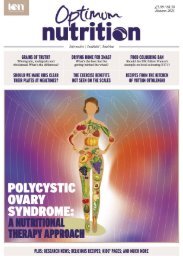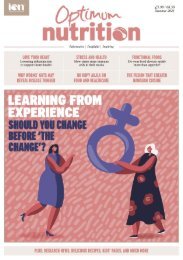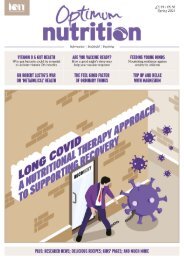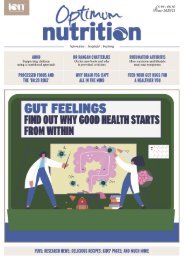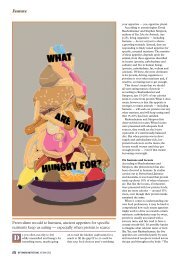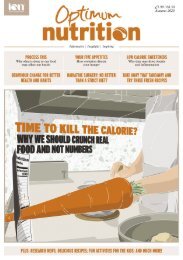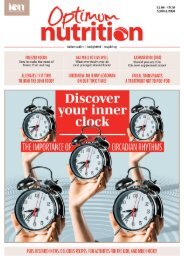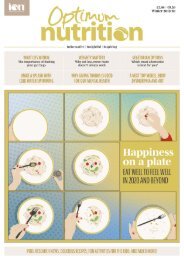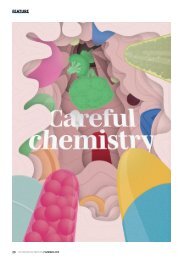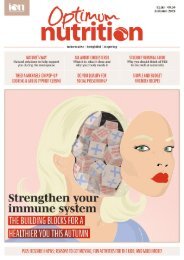Create successful ePaper yourself
Turn your PDF publications into a flip-book with our unique Google optimized e-Paper software.
NUTRITION NEWS, ONLINE OR DIRECT TO YOUR DOOR<br />
<strong>Optimum</strong> <strong>Nutrition</strong> magazine<br />
Features, research news, recipes, practical nutrition tips and commentary, in our quarterly magazine – delivered direct to your<br />
door or online to read whenever, wherever. Current and back issues also available from: www.magzter.com.<br />
The Institute for <strong>Optimum</strong> <strong>Nutrition</strong>’s free monthly newsletter<br />
Sign up for research news, events, and at least one tasty recipe, direct to you inbox.<br />
For magazine and/or newsletter, visit: www.ion.ac.uk/optimum-nutrition-magazine-newsletter<br />
www.ion.ac.uk | info@ion.ac.uk | @ion_nutrition | instituteforoptimumnutrition | 020 8614 7800
CONTENTS<br />
8 16 20<br />
THIS ISSUE<br />
TIRED ALL THE TIME?<br />
So many of us are struggling to get<br />
through the day that ‘TATT’ has<br />
now become a common acronym<br />
used by GPs. Jackie Lynch, a<br />
registered nutritionist and author,<br />
looks at how to use nutrition to<br />
get back your va va voom<br />
RAISE A DIFFERENT GLASS<br />
If you’re looking to cut back or cut<br />
out alcohol or fizzy drinks, read on.<br />
Louise Wates writes why alcoholfree<br />
wine is now a regular tipple<br />
of choice, and Ellie Smith looks at<br />
how cutting down on fizzy drinks<br />
could benefit our health<br />
INTERVIEW<br />
Max MacGillivray knows a thing<br />
or two about fresh fruit and<br />
vegetables and wants the UK’s<br />
children to know about them too.<br />
So last year, he toured Africa on a<br />
motorbike just to show children at<br />
home a world of fresh food<br />
REGULARS<br />
14 ALL ABOUT<br />
With warmer weather on its way, it’s time<br />
to bring out the salad spinner. For some,<br />
however, raw food is a year-round way of<br />
life. Jenna Sinclair writes<br />
24 ON YOUR PLATE<br />
If you are looking for something fresh and<br />
vibrant to liven up your lunch, why not<br />
try one of these recipes from LEON Happy<br />
Salads, by Jane Baxter and John Vincent<br />
32 WORLD CUISINE<br />
Japan has the highest life expectancy in<br />
the world, and diet is a big part of this.<br />
Food writer Nancy Singleton Hachisu told<br />
us what makes Japanese cuisine special<br />
34 DIFFERENT STROKES<br />
<strong>Spring</strong>, when the trees begin to bloom,<br />
is the perfect time to take up ‘forest<br />
bathing’, the practice of immersing<br />
oneself in nature to calm the senses<br />
42 FEATURE<br />
When bowel movements for your child<br />
are difficult or distressing, it is time to<br />
take action. Catherine Morgan writes on a<br />
problem that is not exclusive to children<br />
44 LITTLE LIVES<br />
Catherine Morgan considers ways to<br />
shake up breakfast, and we find out how<br />
some experts think we should be tackling<br />
childhood obesity<br />
29 FOOD FACT FILE<br />
We look at why environmental<br />
campaigners are concerned about palm<br />
oil, and whether we should be worried<br />
about the nitrites in our bacon<br />
36 FEATURE<br />
As a nation, we love sandwiches. We look<br />
at the rise and rise of the high-street butty<br />
and ask if making some swaps could be<br />
better for our guts — and the environment<br />
48 MOVE IT<br />
Alice Ball investigates the debate<br />
surrounding what macronutrients — carb,<br />
protein, or fat — are best for powering up<br />
before a workout<br />
04 COMMENT / NEWS<br />
12 RESEARCH UPDATE<br />
28 KITCHEN CHEMISTRY<br />
39 BOOK THERAPY<br />
40 PRODUCT NEWS<br />
47 IN SEASON<br />
50<br />
ION GRADUATE STORY<br />
Find out how studying with the Institute<br />
for <strong>Optimum</strong> <strong>Nutrition</strong> changed Catherine<br />
Jeans’ career<br />
SPRING <strong>2018</strong> | OPTIMUM NUTRITION<br />
3
FEATURE<br />
Do you fall out of bed, crash around 3pm, and sofa snooze before supper? Registered nutritionist<br />
Jackie Lynch and author of Va Va Voom* explains how you can put the spring back into your step<br />
There seems to be something of a<br />
low-energy epidemic going on in the<br />
UK; so much so, that TATT (tired all<br />
the time) has become a popular shorthand<br />
amongst doctors, often used to describe<br />
patients who consistently complain of<br />
tiredness when tests reveal no apparent<br />
medical cause.<br />
In my nutrition clinic, I constantly see<br />
people who simply put up with their fatigue<br />
as if it’s completely normal to be dragging<br />
themselves out of bed in the morning;<br />
kick-starting themselves with coffee;<br />
wilting at their work-station; struggling<br />
with the dreaded mid-afternoon slump and<br />
snoozing in front of the TV in the evening.<br />
If they think about it at all, they usually put<br />
it down to their age and a busy life, but<br />
whether they’re 29 or 69, in most cases<br />
diet and lifestyle are the main culprits.<br />
Yet it doesn’t have to be this way,<br />
because it really is possible to make a big<br />
difference to energy levels in a very short<br />
space of time with the right nutrition and<br />
lifestyle. We already hold the key to our<br />
energy ignition — we just need to know<br />
how to switch it on and keep the engine<br />
running effectively.<br />
In my clinic I have seen different types<br />
of tiredness, so it was important for me<br />
to explore how tiredness can vary. In Va<br />
Va Voom, readers can take quizzes to help<br />
discover their energy weak point: lack of<br />
strength and stamina; energy highs and<br />
lows; loss of focus and concentration; or<br />
a constant feeling of exhaustion are all<br />
different ways that people experience<br />
fatigue. Understanding the nature of your<br />
tiredness is the first step to finding the best<br />
diet and lifestyle solution.<br />
In my clinical experience, there are four<br />
key areas that most commonly contribute<br />
to lack of energy, once medical conditions<br />
...there are four key<br />
areas that most<br />
commonly contribute<br />
to lack of energy...<br />
such as hypothyroidism, diabetes, coeliac<br />
disease or iron deficiency anaemia have<br />
all been ruled out. The principles behind<br />
my 10-day energy diet relate to these four<br />
areas:<br />
• Chronic inflammation. Studies have<br />
shown that a constant state of lowgrade<br />
inflammation can contribute to<br />
a general state of tiredness, as well<br />
as specific fatigue-related conditions,<br />
such as chronic fatigue syndrome.<br />
Blood levels of inflammatory markers<br />
such as C-reactive protein and proinflammatory<br />
cytokines have been seen<br />
to be raised in individuals with fatigue. 1<br />
• Blood sugar balance.<br />
• Ensuring optimum levels of the macro<br />
and micronutrients required for energy<br />
supply and production.<br />
• Limiting the factors that deplete energy,<br />
including alcohol, sugar, excess caffeine<br />
or dehydration.<br />
Of course, there are numerous potential<br />
8 OPTIMUM NUTRITION | SPRING <strong>2018</strong>
FEATURE<br />
It really is possible to<br />
make a big difference<br />
to energy levels in a<br />
very short space of<br />
time...<br />
imbalances, deficiencies or biochemical<br />
factors that can impact energy levels but<br />
there are always a few obvious suspects<br />
to target as a first step in a clinical<br />
context.<br />
Blood sugar balance<br />
Any nutritional therapist will tell you that<br />
one size doesn’t fit all when it comes to<br />
a therapeutic approach, but there is one<br />
area that will make a difference to almost<br />
anyone struggling with tiredness and so<br />
it’s usually my first port of call while I’m<br />
waiting for any test results.<br />
Balancing blood sugar is the equivalent<br />
of Energy 101 — in other words, the basics<br />
in maintaining energy levels. Not only<br />
will it make a big difference to anyone<br />
who experiences energy highs and lows<br />
throughout the day and help to regulate<br />
sleep patterns, but as the approach<br />
includes increasing energy-boosting foods<br />
such as wholegrains and vegetables and<br />
avoiding some key robbers such as sugar<br />
and alcohol, the overall benefits can be<br />
considerable.<br />
How does blood sugar impact energy?<br />
Glucose is a primary source of quick<br />
energy for the body, which means that<br />
low blood sugar will leave you feeling<br />
tired, irritable, and unable to focus or<br />
concentrate. The infamous mid-afternoon<br />
energy slump is all about low blood<br />
glucose and is usually a result of relying<br />
on sugary foods or refined carbohydrate<br />
to keep you going. High blood sugar<br />
releases the hormone insulin as an<br />
emergency response, with its highly<br />
efficient hoovering of the blood which will<br />
send the sugar off to be stored in the liver<br />
or in fat cells. As the blood sugar drops,<br />
stress hormones cortisol and adrenaline<br />
are released, generating powerful cravings<br />
for a quick sugary fix and starting the<br />
whole rollercoaster process all over again.<br />
This battle of the hormones throughout<br />
the day can be exhausting and if the blood<br />
sugar drops overnight due to unwise food<br />
or drink choices in the evening, sleep will<br />
be restless and disrupted, leaving you<br />
tired and unrefreshed in the morning.<br />
How to regulate blood sugar<br />
The solution is simple: a combination of<br />
complex carbohydrate, (e.g. wholegrains<br />
and vegetables) and protein, (e.g. meat,<br />
fish, eggs or pulses) with every meal<br />
and snack. This provides slow-release,<br />
sustainable energy for the body which<br />
will help avoid the cravings for sugar<br />
and refined carbohydrate that lead to<br />
trouble. It also has the secondary benefit<br />
of featuring foods that are also rich in iron,<br />
B vitamins and magnesium, which are all<br />
essential for optimal energy production.<br />
That may sound relatively simple, but in<br />
my clinical experience, women tend to be<br />
very poor at eating enough protein and<br />
will often plough on through a busy day<br />
without any protein at all until the evening<br />
meal. They’re also far more likely to skip<br />
meals than men, which will lead to further<br />
blood sugar issues, as the body starts to<br />
run out of fuel. It can take quite a bit of<br />
coaching and encouragement to address<br />
these ingrained habits.<br />
The role of magnesium<br />
When I observe a client experiencing<br />
tension headaches, a sense of clinging<br />
on by the fingertips or feeling tired but<br />
wired so that it’s difficult to switch off<br />
and relax, I think about magnesium. It’s<br />
the multi-tasker of the minerals and<br />
is discreetly responsible for over 300<br />
essential chemical reactions across the<br />
body, which is why a deficiency can cause<br />
a range of different potential symptoms. 2<br />
Magnesium helps to regulate muscle<br />
function, supports our response to stress,<br />
influences blood pressure and nerve<br />
impulses, promotes a healthy digestion, is<br />
important for bone health, and even plays<br />
a role in DNA production. 3<br />
In energy terms, magnesium starts<br />
your engine. If you have a deficiency,<br />
A BOOZY CYCLE OF EXHAUSTION<br />
ALCOHOL might help us to relax but<br />
it can affect the quality of our sleep.<br />
According to Drinkaware, a UK-based<br />
alcohol education charity, although<br />
alcohol can help us get off to sleep<br />
quickly it can cause sleep disruption,<br />
leaving us more tired. Not only might<br />
we need to make more trips in the<br />
night to the toilet, because alcohol<br />
is a diuretic, but we may also spend<br />
less time in deep sleep and more time<br />
in the rapid eye movement (REM)<br />
stage, which means we can feel less<br />
rested in the morning.<br />
Drinkaware recommends avoiding<br />
drinking alcohol before bedtime, to<br />
give the body time to process any<br />
alcohol — with an hour needed on<br />
average to process one unit.<br />
Source: www.drinkaware.co.uk<br />
FOOD SOURCES OF MAGNESIUM<br />
• Leafy, green vegetables such as<br />
spinach<br />
• Nuts<br />
• Brown rice<br />
• Bread (especially wholegrain)<br />
• Fish<br />
• Meat<br />
• Dairy foods<br />
Taking high doses of magnesium<br />
(more than 400 mg) for a short time<br />
can cause diarrhoea.<br />
Source: www.nhs.uk<br />
you’re likely to feel as if you’re running on<br />
empty all the time because it’s absolutely<br />
essential in the energy production process,<br />
activating the enzymes that spark the<br />
entire chain reaction. I find magnesium<br />
very helpful when I’m working with clients<br />
whose tiredness stems from the stress of a<br />
very busy life, because it helps to calm the<br />
nervous system. It can be very supportive<br />
for anyone suffering from chronic fatigue<br />
syndrome because of its core role in<br />
energy production and the part it plays<br />
in supporting muscle function, and it can<br />
also make a big difference to anyone who<br />
suffers from insomnia. 4<br />
How to boost magnesium levels<br />
Good food sources of magnesium<br />
include wholegrain foods, leafy green<br />
vegetables, and sunflower seeds. Including<br />
these in your diet every day can help<br />
to keep magnesium levels topped up.<br />
Supplements should not exceed 400 mg<br />
per day without the advice of a health<br />
professional and, to avoid the risk of<br />
potential harmful interactions, you should<br />
speak to your doctor if you’re taking any<br />
medication. One very relaxing way of<br />
increasing magnesium levels is to try an<br />
Epsom (magnesium) salts bath — add<br />
two to three handfuls of salts in the bath<br />
and relax for at least 20 minutes. The<br />
magnesium will absorb through the skin,<br />
relaxing the muscles, relieving tension, and<br />
setting you up for a good night’s sleep.<br />
B vitamins<br />
A group of individual nutrients, B<br />
vitamins work as a team to support a<br />
range of different functions in the body.<br />
A deficiency of one B vitamin is likely<br />
to indicate a deficiency of another and<br />
because they are so vital for our energy<br />
levels, this can have a domino effect<br />
leading to tiredness and fatigue, which is<br />
why it’s always an area I’ll explore in my<br />
clinic.<br />
SPRING <strong>2018</strong> | OPTIMUM NUTRITION<br />
9
ON YOUR PLATE<br />
TIME 15 mins COOK TIME 8 mins<br />
SERVES 2<br />
(wheat-free/gluten-free/dairy-free)<br />
INGREDIENTS<br />
• 1 chicory head, finely sliced<br />
• ¼ of a radicchio head, finely sliced<br />
• 1 leek, finely sliced<br />
• 200–250 g (7–9 oz) sirloin steak<br />
(or another cut)<br />
• 1 tsp olive oil<br />
• 100 g (3½ oz) chestnut mushrooms,<br />
sliced<br />
• Salt and freshly-ground black pepper<br />
DRESSING<br />
• 2 tbsp mustard mayonnaise<br />
• 1 tbsp chopped chives<br />
METHOD<br />
Mix together the chicory, radicchio and<br />
leek in a large bowl. Heat a griddle pan<br />
until it’s very hot. Brush the steak with<br />
a little olive oil, and season well. Cook<br />
for a couple of minutes on each side and<br />
remove to a plate to rest, uncovered. Add<br />
the mushrooms to the same pan, brown<br />
them for a few minutes, then set to one<br />
side.<br />
Dress the chicory mix with the<br />
mustard mayonnaise, then add the chives<br />
and season. Toss through the cooled<br />
mushrooms. Slice the steak and pop on<br />
top of the dressed salad.<br />
26 OPTIMUM NUTRITION | SPRING <strong>2018</strong>
ON YOUR PLATE<br />
TIME TAKEN 1 hour<br />
SERVES 4 / PREP TIME 30 mins<br />
COOK TIME 10 mins<br />
(dairy-free/use rice noodles to make<br />
wheat-free/gluten-free — soba (buckwheat)<br />
noodles may contain wheat.)<br />
INGREDIENTS<br />
• 4 salmon fillets, about 100 g (3½oz)<br />
each<br />
• 1 tbsp sesame oil<br />
• 200 g (7 oz) black rice noodles (or<br />
soba noodles)<br />
• 50 g (1¾ oz) spinach, cooked and<br />
chopped<br />
• 50 g (1¾ oz) samphire, blanched<br />
• ½ a cucumber, cut into long strips<br />
• 4 spring onions, chopped<br />
• 1 tbsp toasted sesame seeds<br />
• 1 tbsp black sesame seeds<br />
• Fresh coriander leaves<br />
• Salt<br />
• Freshly ground black pepper<br />
DRESSING<br />
• 2 cm (¾ “) piece of ginger, finely grated<br />
• 1 clove of garlic, crushed<br />
• Juice of 1 lime<br />
• 2 tsp runny honey<br />
• 50 ml (2fl oz) sunflower oil<br />
• Salt and cayenne pepper<br />
METHOD<br />
Heat a large griddle pan. Brush the salmon<br />
with the sesame oil and season well. Grill<br />
for 2 minutes on each side, depending on<br />
the thickness of the fillets, until almost<br />
cooked through.<br />
Remove the salmon from the grill and<br />
leave it to rest. Make the dressing by<br />
blending all the ingredients together to<br />
make an emulsion. Cook the noodles in<br />
lots of salted boiling water for 4–5 minutes<br />
and drain well. Refresh with cold water<br />
and toss in a large bowl with the spinach,<br />
samphire, cucumber and dressing.<br />
To serve, place the salmon on top of the<br />
noodles and top with the spring onions,<br />
sesame seeds and coriander leaves.<br />
TIP<br />
For knobbly bits of ginger, try using a<br />
teaspoon to peel.<br />
SPRING <strong>2018</strong> | OPTIMUM NUTRITION<br />
27
MOVE IT<br />
Bananas or a boiled egg? When it comes to the food that fuels your workout, which one reaches<br />
the winning line first? Alice Ball looks at the debate over macronutrients for effective exercise<br />
I’m in the changing rooms of one of<br />
those boutique fitness classes — the<br />
‘you pay bucks for us to kick your<br />
ass’ kind. Despite a stressful morning,<br />
I’ve remembered to grab a banana to<br />
eat before the torture begins. After all,<br />
pre-workout carbs are vital, right? But to<br />
my left is a woman with a physique that<br />
says, ‘I do this every day’ tucking into<br />
two boiled eggs before the class. “Hang<br />
on,” I think to myself. “Have I got this all<br />
wrong?”<br />
When we work out, our body requires<br />
fuel. Food is stored in the body as<br />
glycogen and broken down into glucose<br />
during exercise, feeding the muscles<br />
with energy. We can get glycogen from<br />
most food groups, but carbs are thought<br />
to convert to glucose more easily than<br />
protein or fat. As a result, carbohydrates<br />
are considered to be the energy food;<br />
which is why we often see marathon<br />
runners eating bowls of porridge or<br />
bananas before their race. This is known<br />
as carb-loading; consuming large<br />
quantities of carbohydrates in the run<br />
up to an event to increase the amount of<br />
glycogen in the body. The result? They<br />
can perform for longer without ‘hitting the<br />
wall’.<br />
The body naturally contains enough<br />
glycogen to run the course of an hour’s<br />
workout or 10 km run. But for distance<br />
48 OPTIMUM NUTRITION | SPRING <strong>2018</strong>


